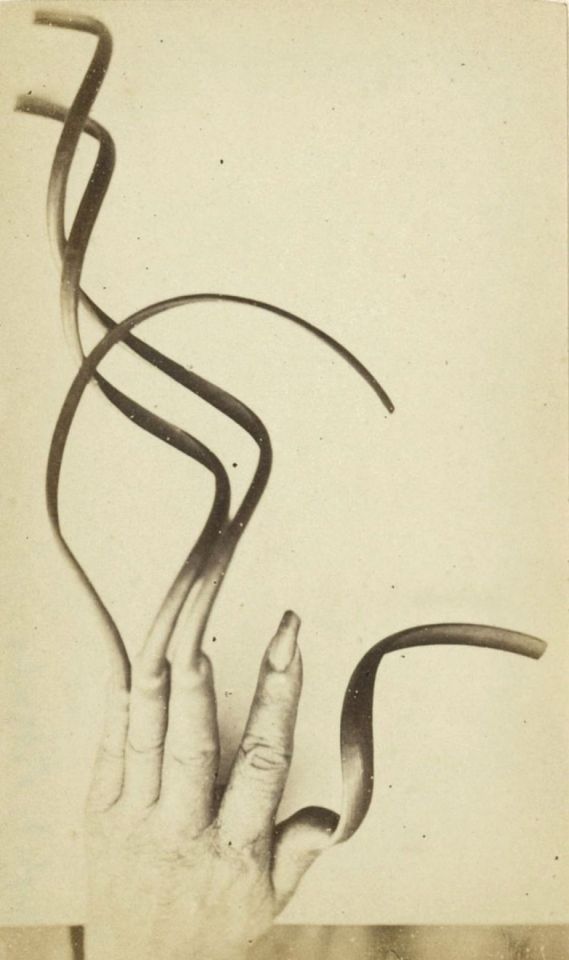#Annamitic
Text
Aristocratic hand · 1870s-1890s

Une Main de Mandarin annamite, ca. 1890 (nr. 72). Planté éditeur (Saigon)
view more on wordPress

Émile Gsell ~ Main d’Annamite, Annam, Cochinchina, ca. 1870, woodburytype. (alternative caption)
Unghie aristocratiche di un mandarino annamita, Indochina, ca. 1870. | src Collezione Molinario
view more images on wordPress
#long nails#annamita#annamite#aristocratic nails#Emile Gsell#indochine#Émile Gsell#cochinchina#hand#hande#indochina#1890s#main#albumen print#mandarin#mano#nails#vintage card#vintage postcard#annam#vintage Postkarte#aristocratic hand#cartolina vintage#aristocracy#tarjeta vintage#1870s#carte postale vintage#unknown
70 notes
·
View notes
Text
Indochina on the left, Belgium on the right.

Our Indochinese riflemen return! Though they wore many uniforms, they are back here with the most characteristic one of WW1, borrowed from the African army and its mustard colour. They however kept their salacco hat, protected by a beige fabric to cover its colours and bearing the metallic anchor of the colonial troops. They wear the standard leather equipment set of the French army and carry the special M1902 'Indochinese' rifle which was made shorter than the standard issues, as Indochinese soldiers were on average shorter than a metropolitan Frenchman.
Cue the Belgian Askari, this time in a more standard uniform as well, and making them look quite like their German rivals. Wearing British web equipment, he also sports a cloth badge on his fez cover which corresponded to different units but unfortunately, History lost its particular assignation.


Sources: Pierre-Albert Leroux and Osprey Publishing.
#ww1 uniforms tournament#wwi#ww1#indochina#belgium#askari#indochinese riflemen#tirailleurs annamites#tirailleurs indochinois
34 notes
·
View notes
Text

leverets of the Annamite striped rabbit (Nesolagus timminsi). photographed by Nikolai L. Orlov & published in Abramov et al. 2016.
#sometimes i just feel compelled to put images on my blog sorry guys#but please gaze at the splendor of the annamite striped rabbit with me#ilove them theyre like the cats of rabbits#leporidae#striped rabbit#rabbits#bunny#rare animals#autumn aesthetic#autumn#animals#bio#my posts#nesolagus timminsi
7 notes
·
View notes
Text



Happy World Saola Day! 🏞️
Did you know that the Saola was only discovered 30 years ago? 😮 They are a Critically Endangered species and very little is known about them.
To learn more about the elusive species, follow the Saola Foundation at saolafoundation.org and sign up to their newsletter for updates on their epic search to #savesaola!
#saola#saolas#Saola foundation#world saola day#conservation#Annamite mountains#critically endangered#species on the brink#endangeredanimals#endangered animals#asap species
136 notes
·
View notes
Text



Bà Nà Hill Station (2) (3) by Phan To Anh Vi
#fog#dreamlike#bridges#statues#cable cars#vietnam#trường sơn mountains#annamite range#annamese mountains
1 note
·
View note
Photo

Othon Friesz - Annamites dans un camp d'aviation (1917)
0 notes
Text


Letter from Nguyen ai Quac [Ho Chi Minh] to Secretary of State Robert Lansing (with enclosure)
Record Group 256: Records of the American Commission to Negotiate PeaceSeries: General RecordsFile Unit: 851G.00
PARIS PEACE CONFERENCE
[much clearer (typewritten or stamped) text (within stamped frame): in black:]
851G.00/1
[/stamp]
A Son Excellence le Secrétaire d'Etat de la
République des Etats-Unis, Délégué à la Conférence de la Paix.
Excellence,
Nous prenons la liberté de vous remettre ci-jointe
la note des Revendications du peuple Annamite à l'occasion
de la victoire des Alliés.
Nous comptons sur votre haute bienveillance pour l'honorer de votre appui auprès de qui de droit.
Nous prions Votre Excellence de vouloir bien agréer l'hommage de notre profound respect.
Pour le Groupe des
Patriotes Annamites.
[stamp (faintly) seen below "Patriotes Annamites." and the signature, with a date within an inner rectangle within a larger rectangular "box";
text within it reads as follows:][outer:] FILE
[inner:] 20 AOUT 1919
[/stamp]
[signature [(above a typewritten blank line):] ] Nguyên Aí Quâc
56, Rue Monsieur le Prince, 56
- Paris -
[complete document, transcription and translation at link]
21 notes
·
View notes
Text
lagomorphs day 562: even more annamite striped rabbits










151 notes
·
View notes
Photo

Captured prisoners of the WWI from eight different nations at an unknown German prisoner of war camp. From left, Annamite (Vietnamese), Tunisian, Senegalese, Sudanese, Russian, American, Portuguese and British. 1917
78 notes
·
View notes
Text

Throwback to this jackalope for no reason in particular 🐰 See below the break for a little info on the Annamite Striped Rabbit!
Annamite striped rabbits are some of the most elusive rabbits in the world! They only come out at night to forage for food in the tropical forests of Vietnam. Unfortunately, it's real life counterpart doesn't have antlers 😆

(Digital painting of Annamite Striped Jackalope by me, photographs by Nikolai Orlov)
#throwback#old art#rabbit#animals#animal art#wildlife#nature#nature lovers#art#digital art#illustration#vetdraws
17 notes
·
View notes
Text
[T]he infamous Diable (Devil’s Island) [French prison in Guiana, South America] [...]. Seventy thousand convicts were sent to French Guiana between 1852 and 1938. [...] Alongside deportation of political prisoners [...], a [...] convict population [...] was sent to the bagne (common parlance for the penal colony) [...] as a utopian colonial project [...] via the contribution convict labour would make towards colonial development in French Guaina. However, [...] French Guiana [...] was predominantly used as a depository for the unwanted citizens of France and its colonies. The last remaining French and North African convicts were repatriated in 1953, whereas the last Vietnamese prisoners were not given passage home until 1954 [...].
[T]he same form of built environment and carceral technology [...] structures found on Con Dao [French prison in Vietnam] and [the French prison in Guiana] [were] built at almost the same time [...] to house the same convict populations (Vietnamese implicated in anticolonial struggles) [...]. Old world colonialism is thus displaced by new world imperialism. Both rely on the prison island and its cellblocks. [...]
---
The carceral continuities [...] throughout France’s penal colonies are supplemented by legal exceptionalism which works to redefine colonial subjects within shifting political contexts. [...] Many of the Indochinois convicts transported to the forest camps of French Guiana in 1931, including the Bagne des annamites, had originally been classed as political prisoners. The transfer was intended in part [...] to remove a number of anticolonial actors from Indochina. [...]
As political deportees sent to French Guiana were usually exempt from labour according to the political decree of 1850, this status had to be revoked to ensure the maximum labour force possible.
Consequently, those arrested on suspicion of specific acts of violence or property damage were reclassed as common criminals. Described by Dedebant and Frémaux (2012, 7) as “little arrangements between governors,” this was not simply a sleight of hand but written into legal codes. [...]
---
[M]any of the Vietnamese sent to French Guiana had to wait until the 1960s to be repatriated. [...] After their sentences were completed, convicts were not simply repatriated to France or other colonies.
A system of “doublage” intended to shore up colonial development meant they had to serve the same length of their sentence again on the colony. For those condemned to eight years or more, this became life. Opportunities for sustainable livelihood were limited in a territory possessing swathes of free convict labour. Worn out and sick from their time in the bagne, most of these men were unfit to work and relied on charity to survive. [...]
[T]he last living convict [of the Guiana penal colony] [...] died in Algeria in 2007 after being repatriated to Annaba. In an interview given in 2005, he claims that every night he dreams he is back in Cayenne: “when I think about it, I get vertigo, I spent my life there” [...].
---
All text above by: Sophie Fuggle. "From Green Hell to Grey Heritage: Ecologies of Colour in the Penal Colony". Interventions: International Journal of Postcolonial Studies Volume 24, Issue 6. 2022. Published online 8 April 2021. [Bold emphasis and some paragraph breaks/contractions added by me. Presented here for commentary, teaching, criticism purposes.]
#just arrest the activists and send them to the prison labor camp oh wait we arent technically legally allowed to force them to work#then just reclassify them not as political prisoners but instead as general criminals and then we can force them into slavery i mean labor#oh no wait now they finished serving their sentence and we cant force them into labor anymore#wait yes we can just change more rules so they cant go back home and have to work nearby#two or three or four birds with one stone#ecology#abolition#landscape#colonial#imperial#indigenous#multispecies#haunted#caribbean#tidalectics#archipelagic thinking#intimacies of four continents#carceral geography#geographic imaginaries
37 notes
·
View notes
Text
A Denisovan fossil location shakes up our understanding of human evolution with a surprising find in the remote Annamite Mountains of Laos. This find in an unexpected place could rewrite much of what we know about this ancient ancestor.
20 notes
·
View notes
Note
With the Dawnline Shore heating up, fleet action has too. You wouldn't believe how many pirates are popping up and, while Trunk Security is nice, TBH the Annamite Line is too damn big. And that means aux's have to put in some effort too.
As someone that's got two MDSM's under her belt, that grant any discount to Caliban licenses? We're running low on pilots, not near any station, and they want to shove me in one. AND I'm working off a DoJ budget.
~ Sammy Crimson
Hello! We’re happy to hear from such a storied veteran of the fight against piracy, especially one working with the wonderful DoJ/HR. We’d be happy to provide you a discount on the Caliban—humanitarian concerns like yours have always been its intended purpose.
27 notes
·
View notes
Text


#art#traditional art#graphite#pencil drawing#animal#mammal#ungulate#bovine#wild cattle#saola#spindlehorn
18 notes
·
View notes
Photo

Art Deco fashion illustration by André-Edouard Marty for Georges Doeuillet
La Soubrette annamite. Robe du soir de Doeuillet, garnie de ruban (pl.43, La Gazette du Bon ton, 1920 n°6)
For sale: Edition Originale
#illustration#art deco#1920#marty#doeuillet#georges doeuillet#andré-edouard marty#robe du soir#evening dress#la gazette du bon ton#edition originale#fashion illustration#20s illustration
33 notes
·
View notes
Text

Saola (Pseudoryx nghetinhensis)
One of the rarest large animals in the world, the saola first became known to science in 1992. In may of that year, a team of scientists acquired a strange, unknown pair of horns from a local hunter; only a year later, the first photo of a saola was taken from a captive specimen. The saola lives in a small area of tropical forest in the Annamite mountain range on the Indochinese peninsula. It is critically endangered, but unfortunately saola kept in captivity do not live for very long, so conservation efforts have been very difficult.
#markhors-menagerie#animal facts#animals#biology#fun facts#ungulates#even toed ungulates#ruminants#Bovidae#bovini#saola
5 notes
·
View notes